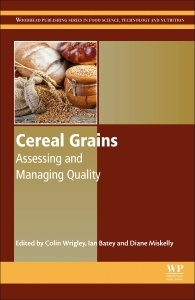Cereal Grains (2nd Ed.) Assessing and Managing Quality Woodhead Publishing Series in Food Science, Technology and Nutrition Series
Coordonnateurs : Wrigley Colin, Batey Ian, Miskelly Diane

Cereal Grains: Assessing and Managing Quality, Second Edition, provides a timely update to this key reference work. Thoroughly revised from the first edition, this volume examines the latest research and advances in the field. New chapters have been added on alternative grains, including ancient grains and pseudocereals, biosecurity, and industrial processing of grains, amongst others.
Quality and food safety are important throughout the value-addition chain, from breeding, production, harvest, storage, transport, processing, and marketing. At all stages, analysis is needed so that quality management can proceed intelligently. These considerations are examined for each of the major cereal species, including wheat (common and durum), rye and triticale, barley and oats, rice, maize (corn), pseudocereal species, sorghum, and the millets. Divided into five sections, the book analyses these for the range of cereal species before a final section summarizes key findings.
Part One: Cereal-grain quality 1. Assessing and managing quality at all stages of the grain chain 2. The cereal grains: providing our food, feed and fuel needs 3. The diversity of uses for cereal grains 4. Cereal-grain morphology and composition
Part Two: Grain-quality characteristics for specific cereals 5. Common wheat: Grain-quality characteristics and management of quality requirements 6. Durum wheat: Grain-quality characteristics and management of quality requirements 7. Rye: Grain-quality characteristics and management of quality requirements 8. Triticale: Grain-quality characteristics and management of quality requirements 9. Barley: Grain-quality characteristics and management of quality requirements 10. Oats: Grain-quality characteristics and management of quality requirements 11. Corn: Grain-quality characteristics and management of quality requirements 12. Rice: Grain-quality characteristics and management of quality requirements 13. Sorghum and millets: Grain-quality characteristics and management of quality requirements 14. Alternative grains: Grain-quality characteristics and management of quality requirements
Part Three: Grain-quality analysis and management 15. Food safety aspects of grain and cereal product quality 16. Breeding for grain-quality traits 17. Identification of grain variety and quality type 18. The effects of growth environment and agronomy on grain quality 19. Analysis of grain quality at receival 20. Grain storage and transport 21. Biosecurity: Safe-guarding quality at all stages of the grain chain
Part Four: Processing cereal grains to optimize product quality 22. Assessing and managing flour quality during and after milling 23. Industrial processing of grains into co-products of protein, starch, oils and fibre 24. Optimisation of end-product quality for the consumer
Part Five: Summary and Appendices 25. Grain quality: the consumer, the scientist, the technologist and the future Appendix 1: Composition of grains and grain products Appendix 2: Equivalence between metric, US and Chinese units for the grain industry
Colin Wrigley’s 45 years in cereal chemistry research have earned him international recognition, in the form of several international and Australian research awards. His work is described in over 500 research publications, including several patents, a series of eight books on Australian cereal varieties and many edited books.
His research interests centre on the characterisation of cereal-grain proteins in relation to processing quality. This has involved developing new methods of protein fractionation, including gel isoelectric focusing and its two-dimensional combination with gel electrophoresis. Other diagnostic methods developed relate to the evaluation of grain quality in wheat and barley, such as better methods for variety identification, and for characterising quality in starch and sprouted grain (as co-patentor of the Rapid ViscoAnalyser). Research involvement also includes elucidation of grain-quality variation due to environmental factors (heat stress, fertiliser use and storage conditions).
Currently, Dr Wrigley is an Honorary Research Fellow at Food Science Australia, in Sydney, and a Consultant to the Value-Added Wheat Cooperative Research Centre. This role includes acting as a mentor to the “next generation of cereal chemists.
Ian Batey has over thirty years of research experience in cereal science. He has published widely and been an Associate Editor of the journal Cereal Chemistry (AACCI) for eighteen years. He is a past recipient of the Founders Award of the Cereal Chemistry Division of the Royal Australian Chemical Institute.
Diane (Di) Miskelly has over forty years’ experience in cereal science and technology in public and private sectors. Including consultancies to wheat, milling and food industries, wheat and grains research, Asian product research and development and manufacturing and commercial customer and internal company technical support in raw mate
- Documents the latest research in cereal grains, from their nutraceutical and antioxidant traits, to novel detection methods
- Provides a complete and thorough update to the first edition, analyzing the range of major cereal species
- Presents detailed advice on the management of cereal quality at each stage of production and processing
Date de parution : 01-2017
Ouvrage de 830 p.
15x22.8 cm
Thèmes de Cereal Grains :
Mots-clés :
β-glucan; 'gluten-free' products; adhesives; alkyl resorcinols; analysis; anti-nutritionals; antioxidants; antiquity; ash; baked goods; bakers' asthma; baking; beverages; bio-fuels; biochemical analysis; bioethanol; biofortification; biofuels; biorefineries; biscuits; bread; breakfast cereals; breeding; breeding technologies; brewing; bulgur; cakes; carbohydrates; CARVER + Shock; cereals; chemical composition; class; composite; consumer; contaminants; cookies; cooking quality; corn (Zea mays L.); country elevator; couscous; crackers; cross-species substitution; culture; defects; DNA; dough properties; doughnuts; dry milling; durum wheat; einkorn; electrophoresis; emmer; end-use quality; environment; environmental effects; ergot; ethanol; F1 hybrids; feed; feed uses; feed utilisation; fibre; flat bread; flavour; flour; FODMAP; food; food safety; food utilisation; fuel; fumigants; functional foods; fungicide; genetic transformation; genome; germination; gliadin; gluten; glutenin; glycemic index; GMP; grade; grain post-harvest risk; grain quality; grain standards; growth environment; HACCP; Hagberg falling number; harvesting; homogeneity; identity preservation; insect control; insect resistance; inspection; kamut; legumes; lipids; low FODMAP diet; maize; malt



